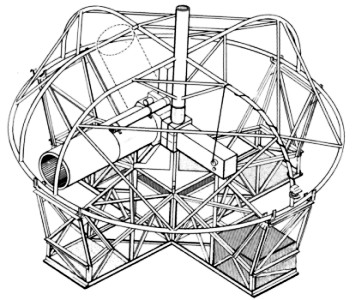Purpose of the flight and payload description
The BUSS experiment was designed to perform spectrophotometric measurements of the stars in the UV domain. The telescope was mounted on a biaxial pointer, and was controlled in elevation and azimuth by a boresighted startracker. Both the telescope-spectrometer and the pointer were designed and built . The telescope has a focal length of 300 cm and a diameter of 40 cm. It consisted of an f/3 primary mirror and a secondary mirror with magnification m = 2.5. By means of image motion compensation an ultimate tracking precision of a few seconds of arc is achieved. The secondary mirror is mounted in a biaxial flex-pivot gimbal system, and can be tilted by means of two small torque motors.
Near the focal plane a dichroic mirror reflects the ultraviolet radiation towards the spectrometer, and transmits the visible light towards a star position sensor, which provides the control signals for the torque motors.
The original payload was designed and built by Ball Brothers Research Corporation of Boulder, Colorado, in 1971. The payload is about 3.5 m in diameter by 2.5 m high and weighs 540 kg, excluding ballast. Crush pads are attached to the four legs of the lower section or gondola, and the roll cage supplies additional protection to the telescope.
Details of the balloon flight
Balloon launched on: 10/7/1971
Launch site: Columbia Scientific Balloon Facility, Palestine, Texas, US
Balloon launched by: NCAR National Scientific Balloon Flight Station
Balloon manufacturer/size/composition: Zero Pressure Balloon Raven - 15.500.000 cuft (0.6 Mil - Cap. 1.0 Mil. X-124)
Flight identification number: 641P
End of flight (L for landing time, W for last contact, otherwise termination time): ??/??/1971
Balloon flight duration (F: time at float only, otherwise total flight time in d:days / h:hours or m:minutes - ): F 11 h 40 m
Payload weight: 1647 lbs
Flight II
External references
- NCAR Scientific Balloon Facility Annual Report, 1971 National Center for Atmospheric Research, February 1972
- Observations of the Stellar MG II Resonance Doublet at 2795 and 2802 Å Astrophysical Journal, vol. 176, p.153
5033If you consider this website interesting or useful, you can help me to keep it up and running with a small donation to cover the operational costs. Just the equivalent of the price of a cup of coffee helps a lot.


